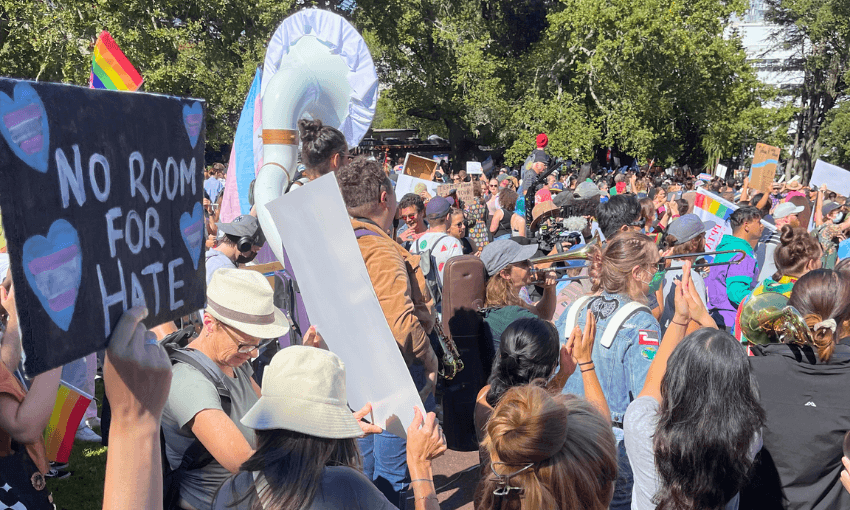Reports have described the protest held at Albert Park on Saturday as angry, chaotic and ugly. This attendee found it to be joyful, life-affirming and full of love.
Climbing the stairs up to Saturday’s counter-rally where anti-trans activist Posie Parker was meant to speak, my husband and I were hit with a wall of noise. Not the revving motorcycles heralding Brian Tamaki’s presence in the city we’d heard earlier, but whistles, drums, horns and music. The noise that has been described in reporting as yelling, booing and heckling.
The point of that noise was to make it impossible for Posie Parker to speak. From where we eventually stood for most of the protest, the soundscape of resistance was also thick with joy. The saxophonist and sousaphone players from the Auckland City Scoundrels stood on a park bench as the second line jazz band smashed out banger after banger. It’s my personal opinion that nothing is more ebullient than a trombone. People danced and cheered.
The crowd itself has been described in reports as angry and the scenes, ugly and chaotic.
It is true that in the thick of things as Parker entered the barricades around the rotunda where she was meant to speak and again when she left, there were heated confrontations. In some ways, that is the nature of protest and I would imagine, anticipated by police. Messages from protest organisers yesterday highlighted safety as a number one priority, advising anyone who might feel unsafe to stay home. For Parker and her supporters not to have anticipated that the consequences of free speech would come home to roost, is either genuine or feigned naivety.
As we arrived in the park, I hugged a friend wearing the trans pride flag around their neck. Another friend apologised for being sweaty as I hugged him, the late March sun and a throng of bodies as unique and beautiful as the colours of the rainbow, raising the temperature a notch.
We moved closer to the rotunda, which was signposted by a big bunch of light pink, light blues and white balloons floating high above the crowd and other couples moved with us, holding hands. Heart-shaped glittered signs told trans whānau they were loved. I hugged more friends. One of them told me that she “fucking loved humanity”. On social media more friends described what was unfolding as a beautiful response to hate. Others captioned their videos that documented the day as “pure trans joy”. A Twitter user brilliantly described the atmosphere as “a cacophony of aroha”.
I attended the protest as an ally. Those of us who can, by dint of simple demographic descriptors, comfortably describe ourselves as the majority were asked to go by organisers. I happily went as a body double for those who encounter violence, bigotry and prejudice because their attempts to just live their lives have become the subject of constant debate and rejection.
Plenty of people have put their bodies on the line for decades at protests and more often than not, they are fighting for their own rights. The image of activists scattering the ashes of their loved ones who had died from AIDS on the lawn of the White House in 1992 is burned into my brain. Many lives were lost during the HIV/AIDS crisis and many people protested as they were dying. Many lives could have been saved if governments had not sat on their hands amid a public health crisis, capitulating to bigotry and weaponised fear.
News value is often found in the reporting of violence or confrontation. This is especially the case when reporting on protests. “This was a very nice protest” or “people milled around” is not really news. The events that take place at a protest should be accurately documented without hyperbole or understatement.
One of the weapons in Parker’s arsenal is fear which is why I think it’s important to provide this alternative view of Saturday’s crowd. Parker frequently references her own safety in concert with her well-worn lines about women’s safety. People like Parker gain attention and support because they’re clever. They carry a grab-bag of political communications and rhetorical tricks. They know which lines work, which deep-seated emotions to tap and they are social media and media-savvy. Before she arrived in New Zealand she wanted it known that police had contacted her and were “worried about” her “safety in your country”. She accuses the media and politicians of telling lies and putting her in grave danger.
To leave people with the impression that the protest was only ugly, angry and chaotic is to assist Parker in feeding the narrative that trans people are people to be feared. In cancelling Parker’s event in Wellington, Speak Up for Women, the group hosting her appearance there, has cited the “violent mob” in Auckland as the reason. That is a convenient mischaracterisation of the crowd.
When asked by police if she had any injuries after leaving the protest, Parker reportedly replied that she just had food in her hair and “grave fears for this place”. Parker need not worry. Yesterday, joy trumped fear and a symphony of fearlessness drowned her out.

